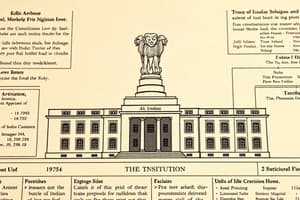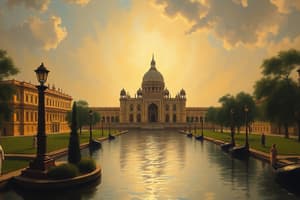Podcast
Questions and Answers
Which of the following best describes the structure of the Indian government?
Which of the following best describes the structure of the Indian government?
- A unitary system where all power resides with the central government.
- A parliamentary democracy with a federal structure and local self-governance. (correct)
- An autocratic monarchy with administrative divisions for efficiency.
- A presidential republic with power equally divided among the center and states.
Prior to 1947, what were the two main entities that comprised India?
Prior to 1947, what were the two main entities that comprised India?
- British India and the Dominion of India.
- The Republic of India and Pakistan.
- The East India Company and the Mughal Empire.
- British India and the Princely States. (correct)
What is the defining characteristic of the parliamentary form of democracy adopted by India?
What is the defining characteristic of the parliamentary form of democracy adopted by India?
- The judicial branch holds supreme power over the executive and legislative branches.
- The executive is responsible to the Parliament. (correct)
- The military controls the executive functions of the government.
- The executive branch is directly elected by the people.
The Indian Constitution's historical background is primarily based on what?
The Indian Constitution's historical background is primarily based on what?
In a federal system like India's, how is power typically distributed?
In a federal system like India's, how is power typically distributed?
Which of the following features of the Indian system of governance has its roots in British administration?
Which of the following features of the Indian system of governance has its roots in British administration?
What was the main characteristic of the Princely States under British rule in India?
What was the main characteristic of the Princely States under British rule in India?
Which of the following is an accurate description of 'British India' before 1947?
Which of the following is an accurate description of 'British India' before 1947?
Flashcards
Pre-Independence India
Pre-Independence India
Before 1947, India was divided into British India and Princely States.
British India
British India
British India consisted of 11 provinces directly under British rule.
Princely States
Princely States
Princely states were ruled by Indian princes under British subsidiary alliance.
Indian Union Formation
Indian Union Formation
Signup and view all the flashcards
Parliamentary Democracy
Parliamentary Democracy
Signup and view all the flashcards
Two Houses of Parliament
Two Houses of Parliament
Signup and view all the flashcards
Federal Governance
Federal Governance
Signup and view all the flashcards
Local Self-Governance
Local Self-Governance
Signup and view all the flashcards
Study Notes
- The historical background of the Indian Constitution is rooted in regulations and acts passed before Indian Independence.
- Before 1947, India consisted of British India (11 provinces) and Princely states.
- Princely states were ruled by Indian princes under a subsidiary alliance policy.
- The two entities merged to form the Indian Union.
- Many legacy systems from British India are still followed.
- Indian democracy is a Parliamentary form where the executive is responsible to the Parliament.
- The Parliament has two houses: Loksabha and Rajyasabha.
- The governance is Federal, with separate executives and legislatures at the Center and States.
- Self-governance exists at local government levels.
- These systems are legacies of the British administration.
Studying That Suits You
Use AI to generate personalized quizzes and flashcards to suit your learning preferences.




